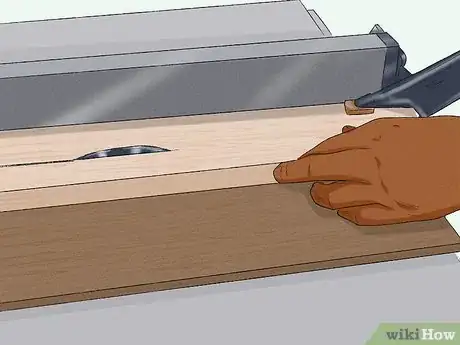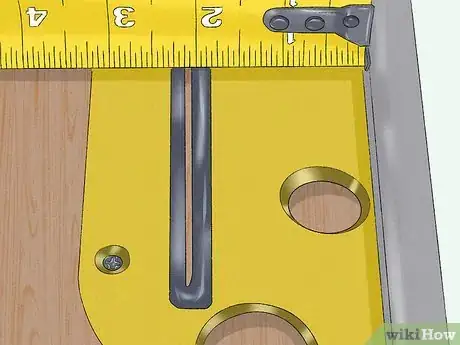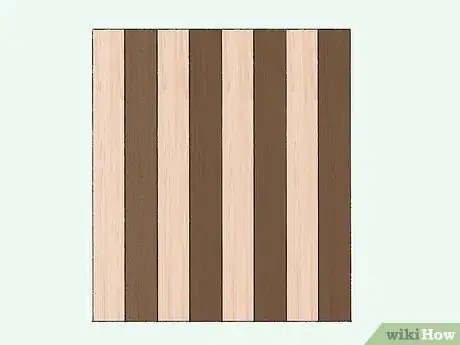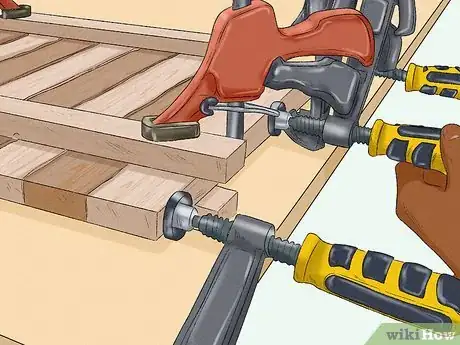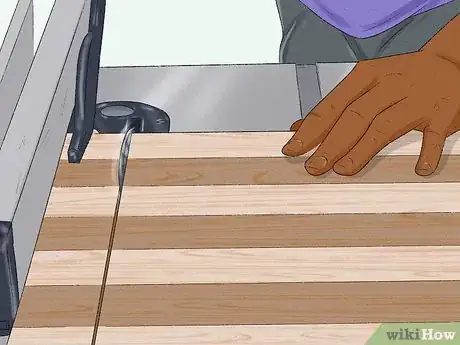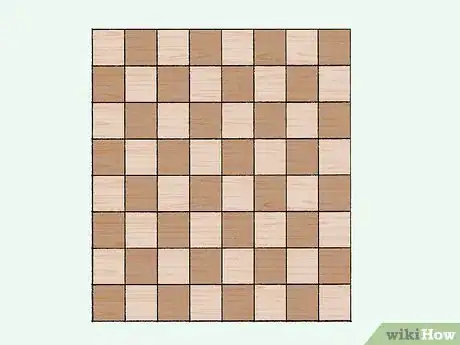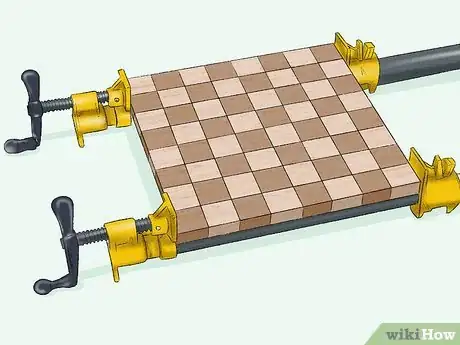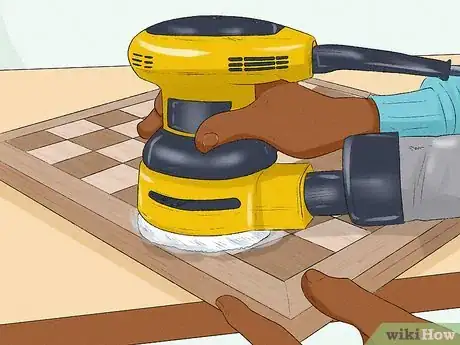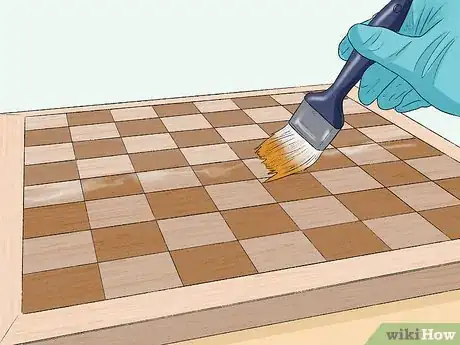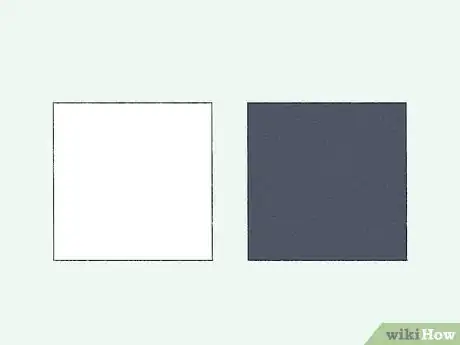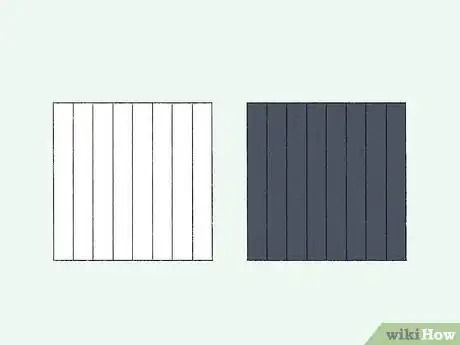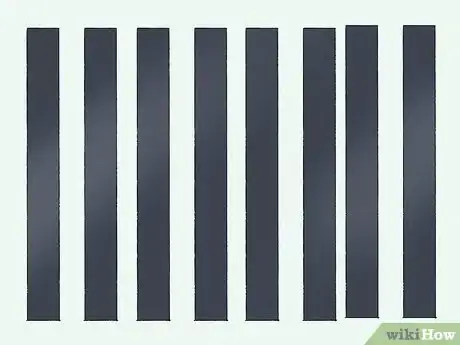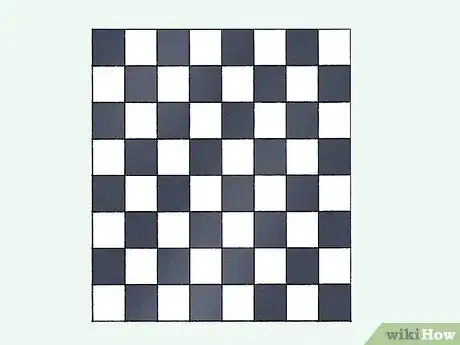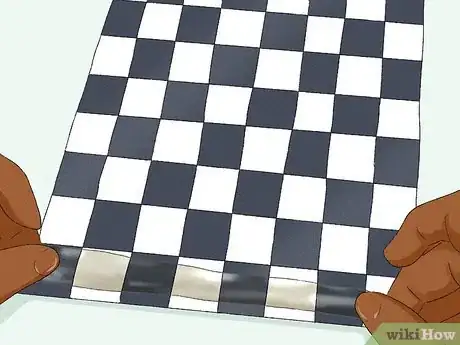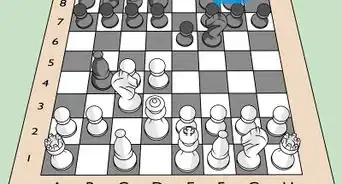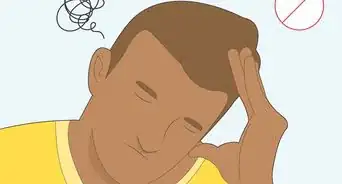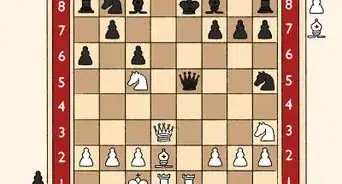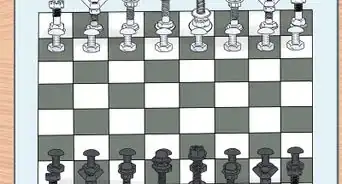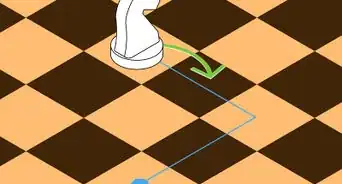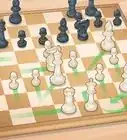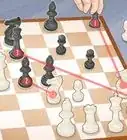This article was co-authored by wikiHow Staff. Our trained team of editors and researchers validate articles for accuracy and comprehensiveness. wikiHow's Content Management Team carefully monitors the work from our editorial staff to ensure that each article is backed by trusted research and meets our high quality standards.
There are 12 references cited in this article, which can be found at the bottom of the page.
This article has been viewed 80,680 times.
Learn more...
Packed with strategy and excitement, chess is a super fun and challenging battle of wits between you and your opponent. But you don’t have to be a grandmaster chess player (or even a master carpenter) to make your own awesome chessboard that you can play with. All you need are a few tools and some quality wood or 2 sheets of black and white paper. With some careful measurements and patience, you’ll be checkmating other players on your handmade board in no time.
Steps
Wooden Chessboard
-
1Use dark and light-colored boards about 1 inch (2.5 cm) thick. Choose 2 different colors of wood to create the alternating pattern of a chessboard. Go with 1 darker and 1 lighter board, each measuring the same thickness.[1]
- For example, you could use maple and mahogany boards, or pine and cedar.
- Visit your local hardware or home improvement store to find quality wooden boards you can use for your chessboard.
-
2Measure and cut 4 18 in (46 cm) strips with a circular saw. Take a ruler or tape measure and a pencil to mark your cut lines so the strips are measured evenly. Use a circular saw to carefully cut the strips out of the boards.[2]
- Be super cautious using the circular saw to cut your strips. Follow your guidelines and don’t rush it.
- The width of the boards isn’t really important because you’ll cut them down to size shortly.
Advertisement -
3Mark cut lines and rip the strips down to 2 in (5.1 cm) wide sticks. Use your ruler or tape measure and pencil to mark your cut lines on the strips. Cut them down to even sticks using your circular saw so you end up with 8 total strips—4 dark and 4 light colored ones.[3]
- The smaller sticks can be trickier to cut with a circular saw, so use extra caution so you don’t risk injuring yourself.
- Pro tip: you can ask one of the staff members at a hardware store if they’re able to cut your boards into to 2 in (5.1 cm) wide sticks to save you the trouble!
-
4Arrange the strips in an alternating pattern and apply wood glue. Lay the strips down on a flat surface like a desk or work table. Arrange them in alternating dark and light colors and line them up evenly. Take your wood glue and add a line along the outer edge of each of the strips. Spread the glue around the edge to create an even layer. Then, press the strips together to form an even square.[4]
- If there’s any excess glue that oozes out between the strips, wipe it up with a cloth before it has a chance to dry.
-
5Clamp the edges of the board with bar clamps and let the glue dry. Take your bar clamps and attach them to the outer edges of the board. Tighten them until the wooden strips are firmly fastened together, but not so tight that it causes the wood to buckle or warp. Check the packaging of the glue for specific drying times and allow it to fully dry and harden.[5]
- Some wood glue may recommend that you leave it clamped for a full 24 hours to allow it to dry completely.[6]
-
6Cut out 2 in (5.1 cm) strips with an alternating pattern from the board. Once the glue is dry, take your ruler or tape measure and pencil and make guidelines across the alternating pattern. Use your circular saw to make the cuts perpendicular to the original strips so you have even strips with alternating light and dark squares.[7]
-
7Arrange the strips to form a checkerboard pattern and apply wood glue. Lay the strips of alternating colored squares on a flat surface like a desk or work table. Line them up evenly to create the classic checkerboard pattern. Spread a line of wood glue to the outer edges of the strips and spread it around to form a thin, even layer. Press the strips together and make sure they’re still lined up evenly.[8]
- You’re almost there! Doesn’t it look good?
- Wipe up any excess glue with a cloth before it has a chance to dry.
-
8Clamp the board together and let the glue dry. Take your bar clamps and attach them to the outer edges of the board just like you did with the strips before you cut them. Allow the glue to fully dry according to the recommended time on the packaging.[9]
- It’s super important that the glue fully dries and hardens so it’s strong enough to keep your board connected.
- If you want to add a border to the edge of your chessboard, measure the length of the sides of your board and cut 4 strips from 3⁄4 by 1 inch (1.9 by 2.5 cm) wood. Spread an even, thin layer of wood glue to the edge of the strips and clamp them into place until the glue dries.[10]
-
9Sand the board with increasingly fine-grit sandpaper until it’s smooth. Once the glue is fully dry, take sandpaper or an electric sander and start sanding the surface with 80-grit sandpaper. Work your way up to a fine 120-grit sandpaper and go over the surface of your board evenly to polish it smooth.[11]
- You can sand the board by hand with sandpaper, but an electric sander is much quicker and easier.
-
10Apply wood finish over the board and let it dry to complete the board. Choose a wood finish that you like and wipe a thin layer over the surface of your board to seal the wood and add to the final look of it. Allow the wood finish to fully dry according to the directions on the packaging and your board is all finished![12]
- Look for wood finish at your local hardware store or home improvement store.
Paper Chessboard
-
1Use a square sheet of black paper and a square sheet of white paper. Choose 2 sheets of paper, one white and one black, to create the classic checkerboard pattern. Use square paper so to make measurements easier and more exact.[13]
- If you don’t have square paper, trim the paper so it measures 20 by 20 centimetres (7.9 by 7.9 in).
- You can also use construction paper if you want a sturdier board.
-
2Measure and draw lines spaced out 2.5 inches (6.5 cm) apart. Use a ruler and a pencil to draw straight lines across the paper. Make sure the lines are evenly spaced apart from each other so you can use them for your board. Draw the lines on both sheets of paper as well. A regulation chessboard has squares that are between 2 to 2.5 inches (5 and 6.5 centimeters), so measure your lines so they match an official board.[14]
-
3Cut out the strips of paper with a pair of scissors. Take a pair of scissors and cut along the lines that you marked. Cut out all of the strips from both sheets of paper.[15]
- Make sure the strips are neat and even!
-
4Arrange the black strips in a row on a flat surface. Place your strips of black paper on a flat surface like a desk or table. Line them up so they’re even and facing the same direction.[16]
-
5Slide the white strips horizontally between them to form a pattern. Take 1 strip of white paper and weave it between the bottom edges of the strips of black paper to form an alternating black and white pattern. Continue weaving the remaining strips of white paper between the black strips until you’ve formed a square with the classic checkerboard pattern.[17]
- Make sure all of the edges of the board are even.
-
6Cover both sides of the board with clear tape. Pull off a strip of clear tape and lay it over the surface of the paper chessboard. Cover the entire surface with strips of clear tape, then flip the paper board over and cover the other side.[18]
- When you’re finished you’ll have a laminated paper chessboard you can use immediately!
Community Q&A
-
QuestionCan I make a chess board using cardboard?
 SuperCommunity AnswerAbsolutely. All a chess board is, is an 8 by 8 grid with alternating colors to form a checker pattern. Use a square piece of cardboard, draw the grid, and then color in every alternating square.
SuperCommunity AnswerAbsolutely. All a chess board is, is an 8 by 8 grid with alternating colors to form a checker pattern. Use a square piece of cardboard, draw the grid, and then color in every alternating square.
Warnings
- Circular saws can cause serious injury if they aren’t used properly. Use them with caution or ask someone with experience to assist you.⧼thumbs_response⧽
Things You’ll Need
Wooden Chessboard
- Dark and light-colored boards about 1 inch (2.5 cm) thick
- Ruler or tape measure
- Pencil
- Circular saw
- Wood glue
- Bar clamps
- Sandpaper (optional: electric sander)
- Wood finish
Paper Chessboard
- 1 sheet of white paper and 1 sheet of black paper
- Scissors
- Pencil
- Ruler
- Clear tape
References
- ↑ https://youtu.be/AmOYsy3pdT8?t=12
- ↑ https://youtu.be/HGYDI0938hE?t=8
- ↑ https://youtu.be/HGYDI0938hE?t=21
- ↑ https://www.popularmechanics.com/home/how-to-plans/how-to/g1501/how-to-build-a-chess-and-checkerboard/
- ↑ https://youtu.be/AmOYsy3pdT8?t=44
- ↑ https://www.woodmagazine.com/materials-guide/adhesives/zimmerman
- ↑ https://www.popularmechanics.com/home/how-to-plans/how-to/g1501/how-to-build-a-chess-and-checkerboard/
- ↑ https://www.popularmechanics.com/home/how-to-plans/how-to/g1501/how-to-build-a-chess-and-checkerboard/
- ↑ https://youtu.be/AmOYsy3pdT8?t=80
- ↑ https://www.popularmechanics.com/home/how-to-plans/how-to/g1501/how-to-build-a-chess-and-checkerboard/
- ↑ https://www.popularmechanics.com/home/how-to-plans/how-to/g1501/how-to-build-a-chess-and-checkerboard/
- ↑ https://www.popularmechanics.com/home/how-to-plans/how-to/g1501/how-to-build-a-chess-and-checkerboard/
- ↑ https://youtu.be/RJeDtUn7xnc?t=18
- ↑ https://www.popularmechanics.com/home/how-to-plans/how-to/g1501/how-to-build-a-chess-and-checkerboard/
- ↑ https://youtu.be/TjaDRDiOOg8?t=34
- ↑ https://youtu.be/RJeDtUn7xnc?t=227
- ↑ https://youtu.be/RJeDtUn7xnc?t=235
- ↑ https://youtu.be/RJeDtUn7xnc?t=567
About This Article
To make your own chess board out of wood, cut a 3/4-inch-thick dowel into 1 3/4 x 1 3/4-inch tiles. You’ll need a total of 64 tiles, with half painted black or another dark color and half painted white or a light color. Cut 4 pieces of 1x2 lumber with angled edges so they fit together like a picture frame, with 2 pieces being 17” long and the other 2 pieces being 14” long. Next, cut a 17x17-inch piece of plywood. Glue the tiles into place in an 8x8 square with alternating colors, then nail or glue the frame to the board so the shorter boards are wedged inside of the longer ones. To learn how to make a chess board out of tile, read on!

